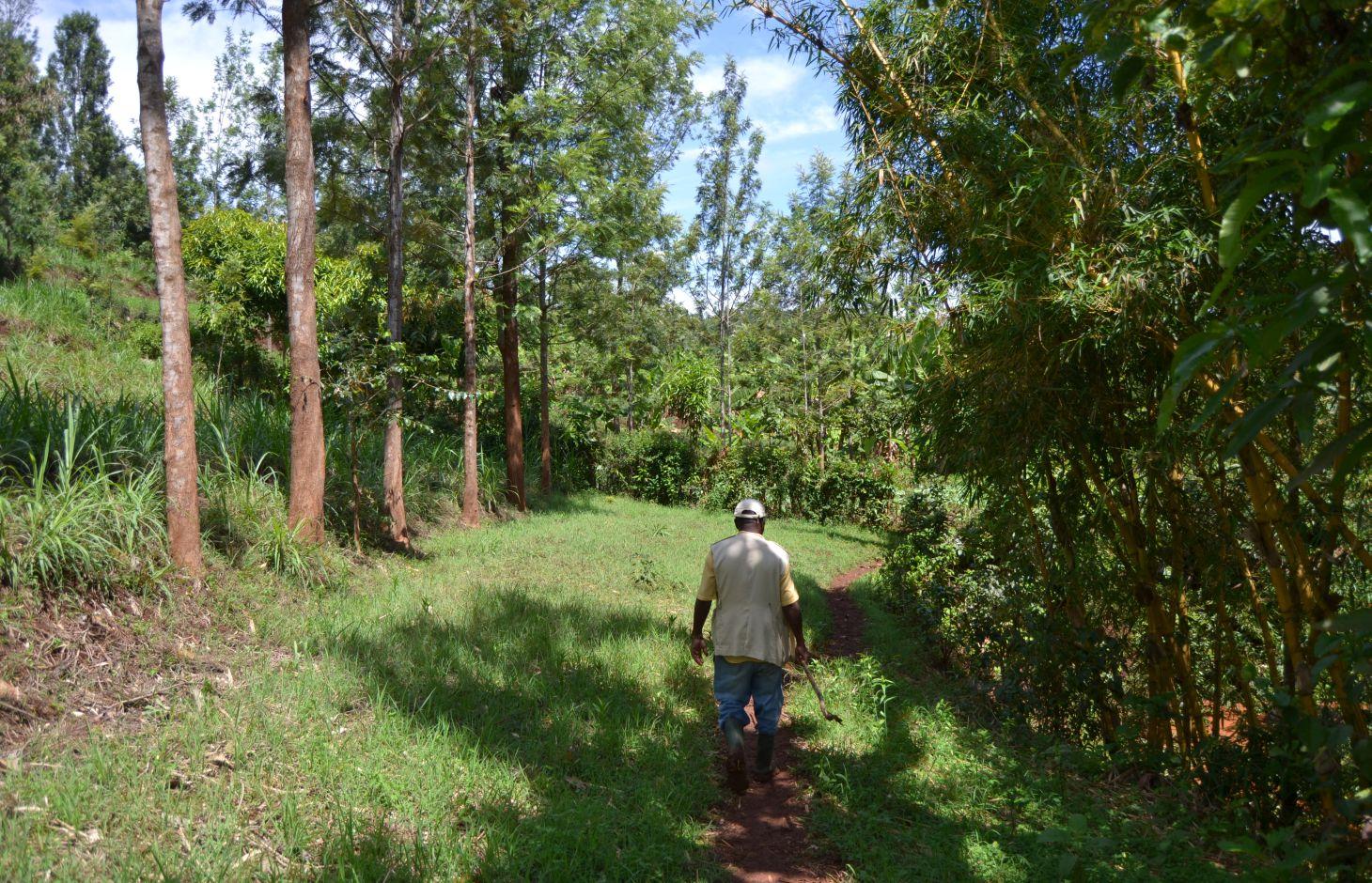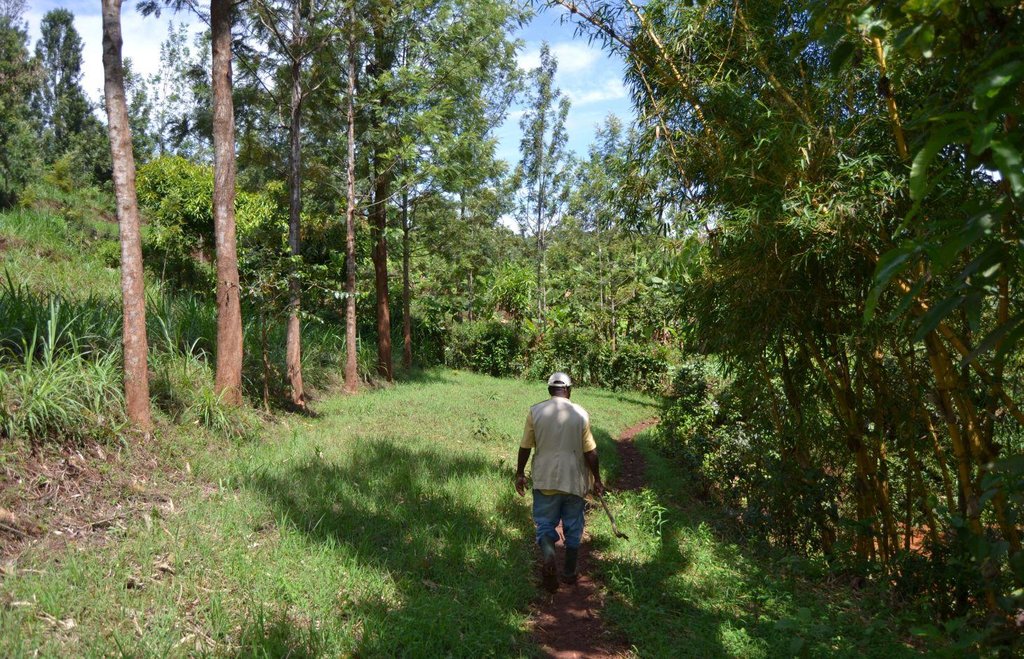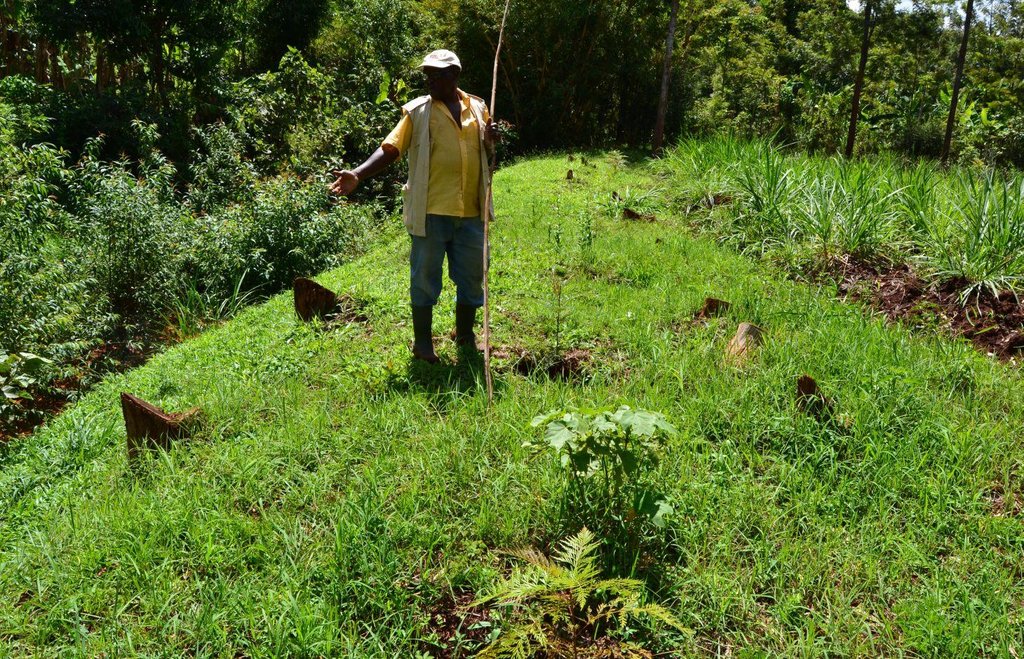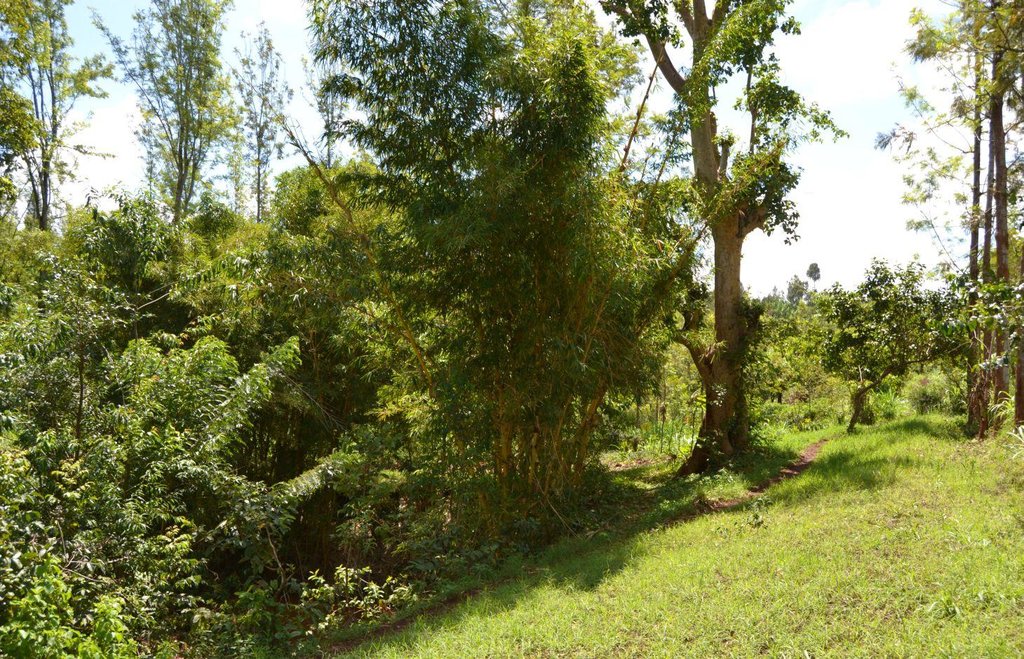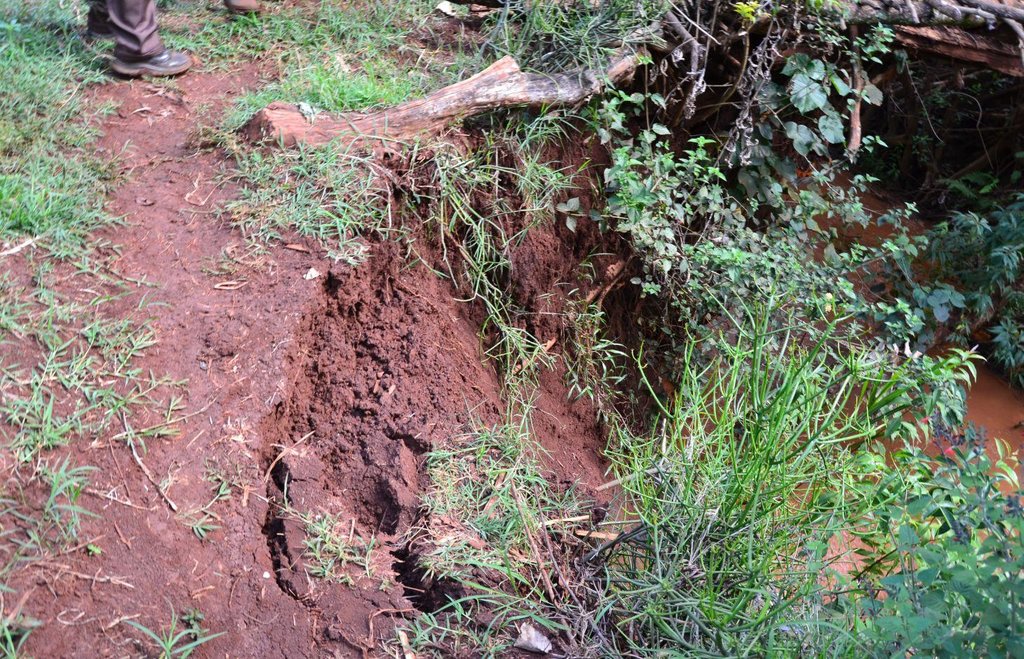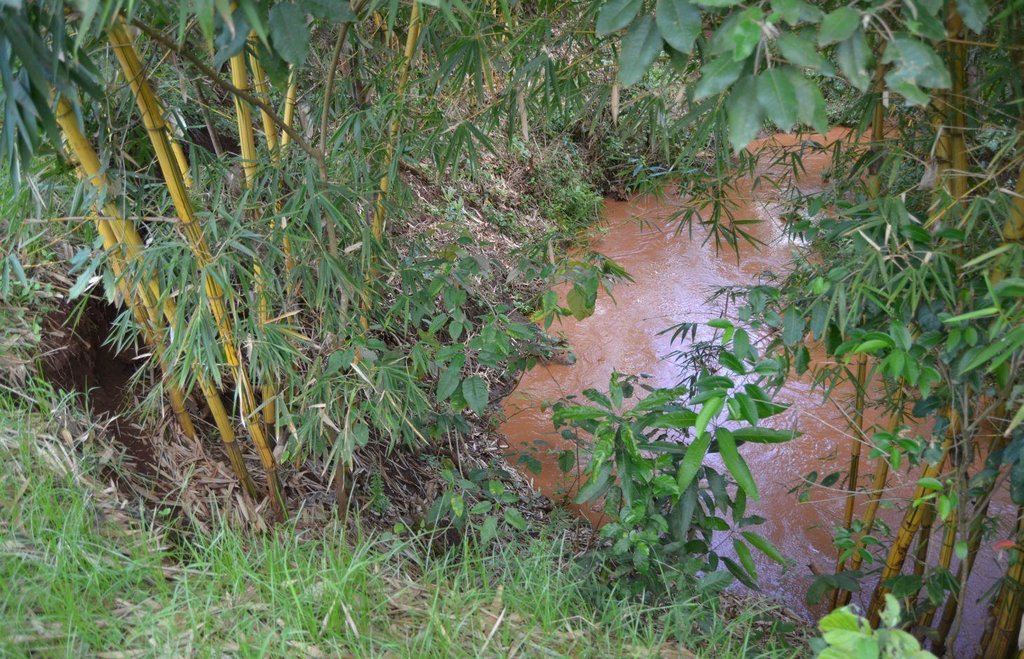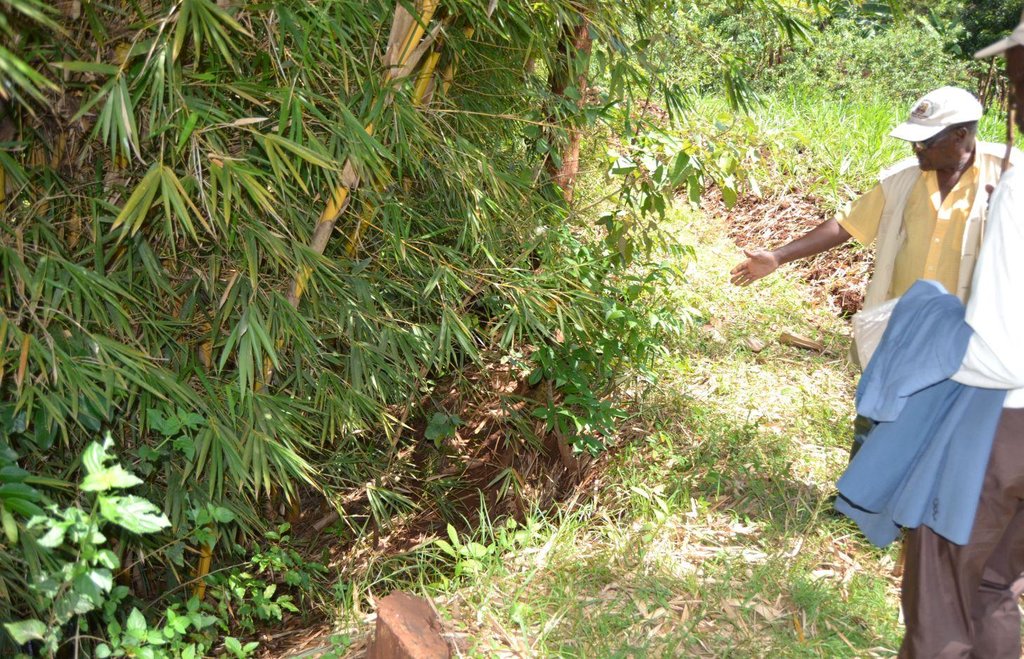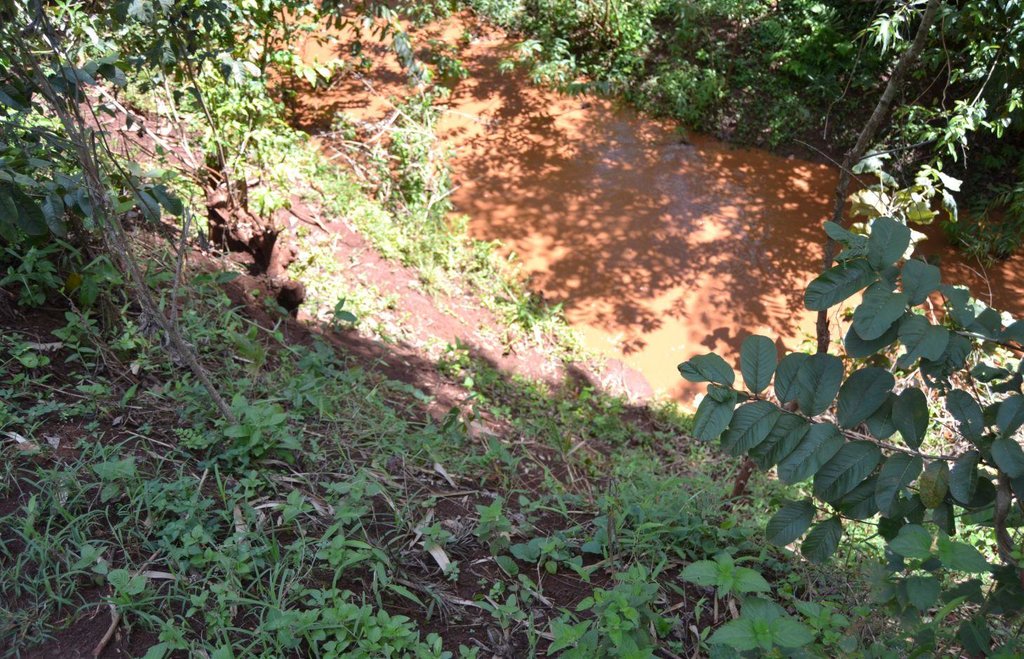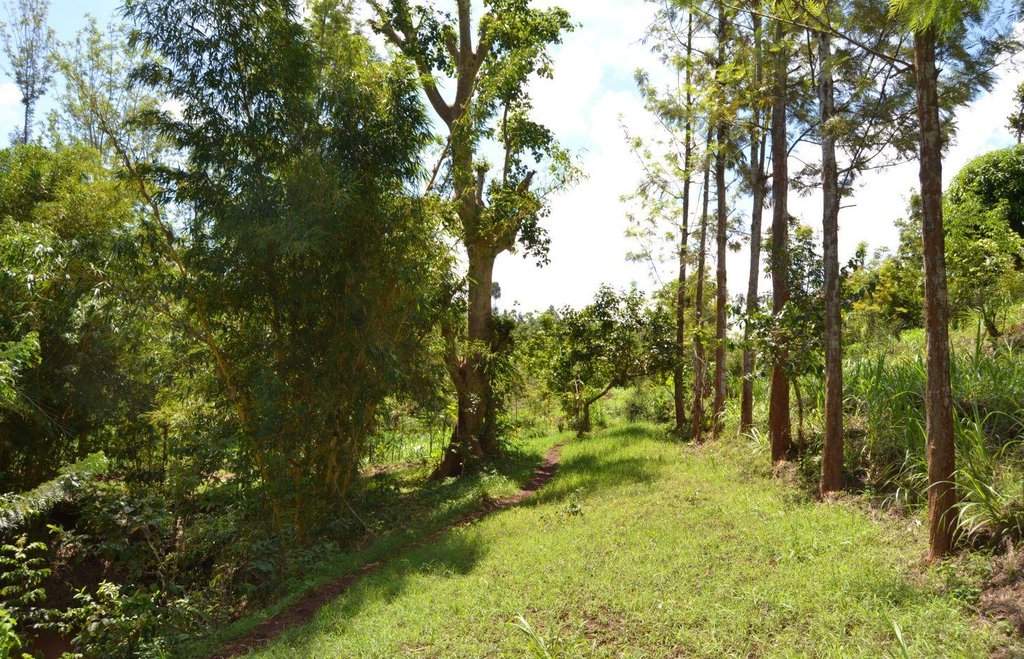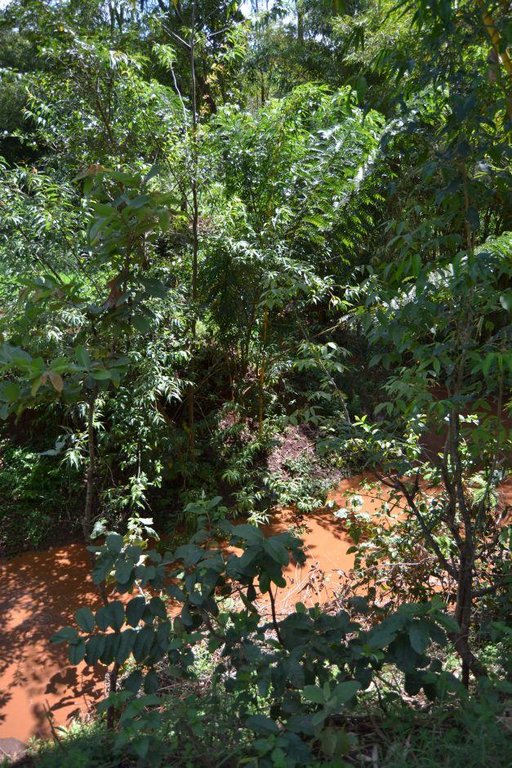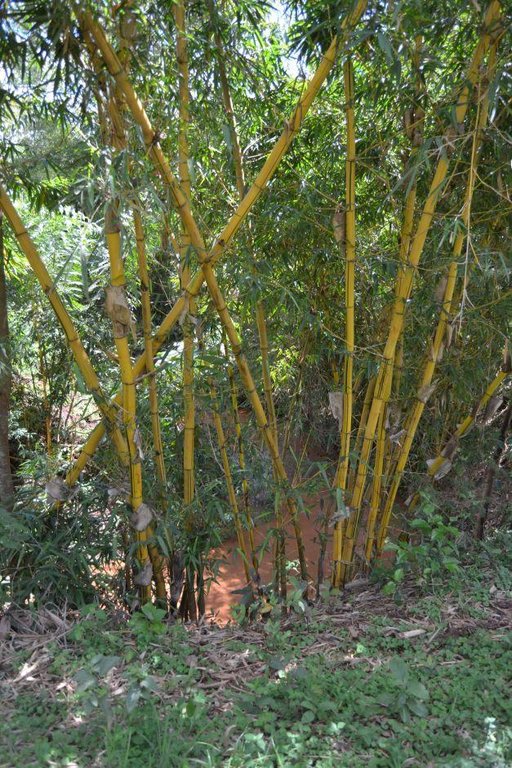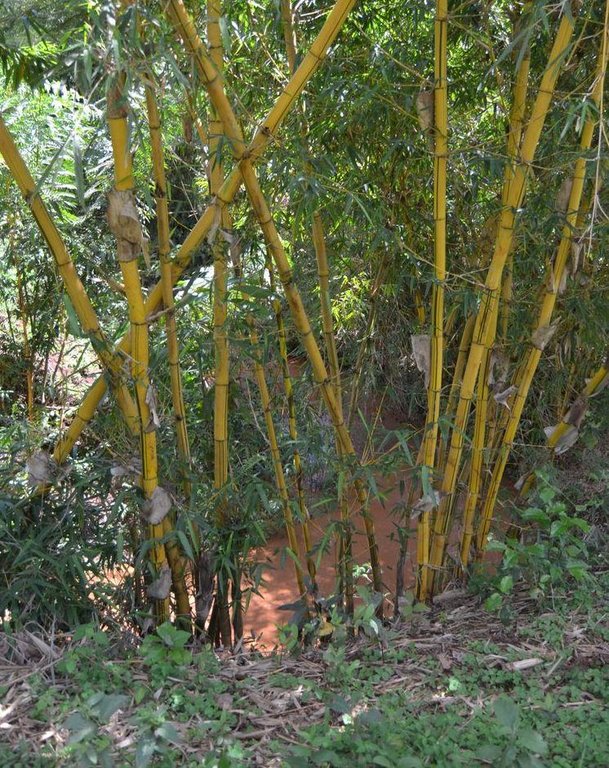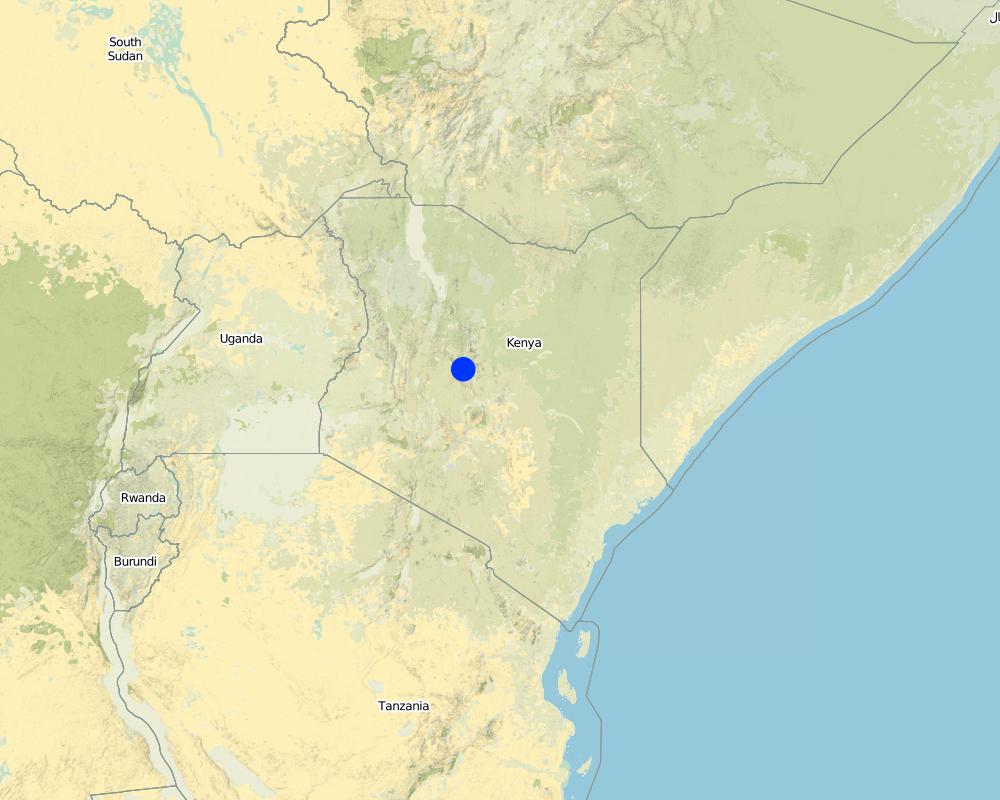Planting Bamboes and Grevillea for Riparian Land Conservation [Kenia]
- Creación:
- Actualización:
- Compilador: Laura D'Aietti
- Editor: –
- Revisores: David Streiff, Alexandra Gavilano
technologies_1135 - Kenia
Visualizar secciones
Expandir todo Colapsar todos1. Información general
1.2 Detalles de contacto de las personas de referencia e instituciones involucradas en la evaluación y la documentación de la Tecnología
Especialista MST:
F. K. Nyamu Joseph
Saba Saba WRUA
Kenia
Nombre de la(s) institución(es) que facilitaron la documentación/ evaluación de la Tecnología (si fuera relevante)
FAO Food and Agriculture Organization (FAO Food and Agriculture Organization) - ItaliaNombre de la(s) institución(es) que facilitaron la documentación/ evaluación de la Tecnología (si fuera relevante)
Saba Saba Water Resource Users Association (Saba Saba WRUA) - Kenia1.3 Condiciones referidas al uso de datos documentados mediante WOCAT
El compilador y la/s persona(s) de referencia claves aceptan las condiciones acerca del uso de los datos documentados mediante WOCAT:
Sí
2. Descripción de la Tecnología MST
2.1 Breve descripción de la Tecnología
Definición de la Tecnología:
The technology is based on tree plantation of several species (i.e. Grevillea robusta, Psidium guava, Bambusa vulgaris ) along the riparian land of the farmer.
2.2 Descripción detallada de la Tecnología
Descripción:
The practice carried out voluntary by the farmer consists of planting trees at the edge of the river bank and in its proximity.
Purpose of the Technology: By increasing vegetation cover (started 10 year ago) the intention of the farmer is to reduce and control bank erosion and landslides in the riparian land.
The degradation in this area is in fact evident and it is partially explained by the reduced vegetative cover. The planted trees help to maintain water quality by filtering silt and organic materials from rainwater runoff from the upper area and at the same time reinforce the streambank to control erosion. Another important environmental benefit is the increased carbon allocation from the new root systems.
The farmer also mentioned the interest to continue expanding tree plantation also in view of carbon credit and financial support from local authorities: in particular bamboo, which reaches maturity in few years, can be harvested after about two years and is easy to propagate (vegetatively).
Grevillea trees (timber) are seen by the farmer as a form of saving, and sold out when the farmer is in need of cash, earning between 800 up to 1500 KSh (Kenyan Shillings), depending on the size of the tree and the costs for cutting- transportation (e.g. machine operator between 500-700 KSh).
Establishment / maintenance activities and inputs: The initial inputs for the establishment of the vegetative practices concern mainly labour (e.g. planting trees) and the cost of the seedlings (10 KSh seedlings of Grevillea, 20 KSh of Guava); generally these activities are carried out at the beginning of the rainy season. Pruning of Grevillea is done every three seasons.
Natural / human environment: The climate is sub humid with two rainy seasons (the first starts around March and the second around October). Near the river the area is characterized by gentle slope and deposition of sediments and bank erosion are the main processes; the risks of further degradation and water pollution are reduced by the riparian vegetation and thanks to the good land management practices of the surrounding farmers. The riparian land is the area of min 6-30 m around the river and it is considered by law a protected area; therefore it should be left intact from any human activity (Water Act, 2002). Indeed, the 'control' and daily management is carried out by the riparian farmers in collaboration with Sabasaba WRUA and WRMA, the official authority for the management of the water of the river and the riparian land.
In this site in particular, the water of the river is considered clean by the farmer interviewed, despite the fact that during rainy seasons the sediment loads affect the quality of the water.
2.3 Fotografías de la Tecnología
2.5 País/ región/ lugares donde la Tecnología fue aplicada y que se hallan comprendidos por esta evaluación
País:
Kenia
Región/ Estado/ Provincia:
Kenya
Especifique más el lugar :
GATWAMIKWA village, Kagurumo sublocation, Muthithi location
Comentarios:
Total area covered by the SLM Technology is 0,1 ha m2.
Map
×2.6 Fecha de la implementación
Si no se conoce el año preciso, indique la fecha aproximada:
- hace menos de 10 años (recientemente)
2.7 Introducción de la Tecnología
Especifique cómo se introdujo la Tecnología:
- mediante la innovación de usuarios de tierras
Comentarios (tipo de proyecto, etc.):
Since year 2000 the farmer has been adopted SWC practices: this in reply to the prolonged degrading situation at the hedge of the river: 'natural vegetation was 'not good' and so 'it was no properly holding the soil', he said.
3. Clasificación de la Tecnología MST
3.1 Propósito(s) principal(es) de la Tecnología MST
- reducir, prevenir, restaurar la degradación del suelo
3.2 Tipo(s) actuales de uso de la tierra donde se aplica la Tecnología

Tierras cultivadas
- Cosecha de árboles y arbustos
Cultivos de matorrales y arbustos - Especifique cultivos:
- mango, mangostán, guayaba
Número de temporadas de cultivo por año:
- 2
Especifique:
Longest growing period in days: 122 Longest growing period from month to month: from about March to June Second longest growing period in days: 61 Second longest growing period from month to month: from about October to November

Bosques
- few lines of Grevillea/Bamboes (According to the definitions adopted FAO (FRA, 2010) the land could not be considered as wooded land (less than 0.5 ha).)
Tipo de árbol:
- Bambúes
- Grevillea robusta
Productos y servicios:
- Conservación/ Protección de la naturaleza
- source of cash
Comentarios:
Tree plantation of several species (i.e. Grevillea robusta, Psidium guava, Bambusa vulgaris )
Major land use problems (compiler’s opinion): Risk of bank erosion and deposition of sediments in the river. See Appendix 3. Fig. 2.
Major land use problems (land users’ perception): Bank erosion. See Appendix 3. Fig. 3
Other type of forest: few lines of Grevillea/Bamboes: According to the definitions adopted FAO (FRA, 2010) the land could not be considered as wooded land (less than 0.5 ha).
Problems / comments regarding forest use: Bamboos are planted because of environmental benefits of this plant to stabilize riverbank. Other potential uses: e.g. wood is used to make baskets, fences and various kind of construction; leaves are used to feed chickens. The hollow sections between nodes are used to make containers. Indeed, the farmer let neighbours to clear and use some bamboos.
Forest products and services: nature conservation / protection
Other forest products and services: source of cash
3.5 Grupo MST al que pertenece la Tecnología
- cobertura de suelo/ vegetal mejorada
- variedades vegetales/ razas animales mejoradas
3.6 Medidas MST que componen la Tecnología

medidas agronómicas
- A7: Otros

medidas vegetativas
- V1: Cubierta de árboles y arbustos
Comentarios:
Main measures: vegetative measures
Secondary measures: agronomic measures
Type of vegetative measures: aligned: -along boundary, scattered / dispersed
3.7 Principales tipos de degradación del suelo encarados con la Tecnología

erosión de suelos por agua
- Wm: movimiento de masas / deslizamientos de tierra
- Wr: erosión de riberas

degradación del agua
- Hq: reducción de la calidad de subterráneas
Comentarios:
Main type of degradation addressed: Wr: riverbank erosion, Hp: decline of surface water quality
Secondary types of degradation addressed: Wm: mass movements / landslides
Main causes of degradation: deforestation / removal of natural vegetation (incl. forest fires) (Poor vegetation cover, mainly herbaceous), Heavy / extreme rainfall (intensity/amounts) (Especially during wet seasons: March-June and October-November)
Secondary causes of degradation: other natural causes (avalanches, volcanic eruptions, mud flows, highly susceptible natural resources, extreme topography, etc.) specify (Footslope area (sediments deposition)), land tenure (Previous poor management SWC measures, especially in the upper areas)
3.8 Prevención, reducción o restauración de la degradación del suelo
Especifique la meta de la Tecnología con relación a la degradación de la tierra:
- prevenir la degradación del suelo
- reducir la degradación del suelo
Comentarios:
Secondary goals: prevention of land degradation
4. Especificaciones técnicas, actividades de implementación, insumos y costos
4.1 Dibujo técnico de la Tecnología
Especificaciones técnicas (relacionadas al dibujo técnico):
Bamboos planted at the hedge of the river; a line of Grevillea, which demarcate the farmer's property and Guava seedlings planted in the riparian land.
Technical knowledge required for land users: low (E.g. Planting bamboos is easy since colony species which use rhizome to spread.)
Main technical functions: control of dispersed runoff: impede / retard, improvement of ground cover, stabilisation of soil (eg by tree roots against land slides), improvement of water quality, buffering / filtering water
Secondary technical functions: improvement of topsoil structure (compaction), increase of infiltration, increase / maintain water stored in soil, sediment retention / trapping, sediment harvesting, promotion of vegetation species and varieties (quality, eg palatable fodder)
Aligned: -along boundary
Vegetative material: T : trees / shrubs
Number of plants per (ha): 25
Vertical interval within rows / strips / blocks (m): 1.5
Width within rows / strips / blocks (m): 0.5
Scattered / dispersed
Vegetative material: T : trees / shrubs, F : fruit trees / shrubs
Number of plants per (ha): 55
Vertical interval within rows / strips / blocks (m): few cm
Trees/ shrubs species: (25) Grevillea robusta (Mũkĩma)
Fruit trees / shrubs species: (5) Psidium guajava (Mũbera), (50 sps) Bambusa vulgaris (Mũrangi)
Slope (which determines the spacing indicated above): 3%
4.2 Información general sobre el cálculo de insumos y costos
Especifique la moneda usada para calcular costos:
- USD
4.3 Actividades de establecimiento
| Actividad | Momento (estación) | |
|---|---|---|
| 1. | Digging holes / Planting pits (1 feet×1feet Grevillea) | Beginning of the season (March/April) |
4.4 Costos e insumos necesarios para el establecimiento
| Especifique insumo | Unidad | Cantidad | Costos por unidad | Costos totales por insumo | % de los costos cubiertos por los usuarios de las tierras | |
|---|---|---|---|---|---|---|
| Mano de obra | Digging holes | Persons/day | 4,0 | 1,75 | 7,0 | 100,0 |
| Material para plantas | Seedlings Grevillea | pieces | 25,0 | 0,28 | 7,0 | 100,0 |
| Material para plantas | Seedlings Guava | pieces | 5,0 | 0,2 | 1,0 | 100,0 |
| Costos totales para establecer la Tecnología | 15,0 | |||||
| Costos totales para establecer la Tecnología en USD | 15,0 | |||||
4.5 Actividades de establecimiento/ recurrentes
| Actividad | Momento/ frequencia | |
|---|---|---|
| 1. | Pruning Grevillea and let branches dry for firewood | Every 3 seasons |
| 2. | Clearing Grevillea for sale | When in need of cash (not regularly), at least 5 years after planting |
4.6 Costos e insumos necesarios para actividades de mantenimiento/ recurrentes (por año)
| Especifique insumo | Unidad | Cantidad | Costos por unidad | Costos totales por insumo | % de los costos cubiertos por los usuarios de las tierras | |
|---|---|---|---|---|---|---|
| Mano de obra | Pruning Grevillea | Persons/day | 1,0 | 4,0 | 4,0 | 100,0 |
| Mano de obra | Clearing Grevillea for sale | Persons/day | 1,0 | 7,0 | 7,0 | 100,0 |
| Indique los costos totales para mantenecer la Tecnología | 11,0 | |||||
| Costos totales para mantener la Tecnología en USD | 11,0 | |||||
Comentarios:
Machinery/ tools: shovel, machete, hoe
The costs summarized above have been calculated considering one year activities; Bamboos do not require establishment/maintenance costs and therefore do not appear in the balance sheet costs.
4.7 Factores más determinantes que afectan los costos:
Describa los factores más determinantes que afectan los costos:
An important constraining factor is labour cost for clearing Grevillea.
5. Entorno natural y humano
5.1 Clima
Lluvia anual
- < 250 mm
- 251-500 mm
- 501-750 mm
- 751-1,000 mm
- 1,001-1,500 mm
- 1,501-2,000 mm
- 2,001-3,000 mm
- 3,001-4,000 mm
- > 4,000 mm
Especificaciones/ comentarios sobre la cantidad de lluvia:
Two wet seasons: March-June and October-November. Dry periods: December- February and July- October
Zona agroclimática
- Sub-húmeda
Thermal climate class: subtropics. June, July and August
5.2 Topografía
Pendientes en promedio:
- plana (0-2 %)
- ligera (3-5%)
- moderada (6-10%)
- ondulada (11-15%)
- accidentada (16-30%)
- empinada (31-60%)
- muy empinada (>60%)
Formaciones telúricas:
- meseta/ planicies
- cordilleras
- laderas montañosas
- laderas de cerro
- pies de monte
- fondo del valle
Zona altitudinal:
- 0-100 m s.n.m.
- 101-500 m s.n.m.
- 501-1,000 m s.n.m
- 1,001-1,500 m s.n.m
- 1,501-2,000 m s.n.m
- 2,001-2,500 m s.n.m
- 2,501-3,000 m s.n.m
- 3,001-4,000 m s.n.m
- > 4,000 m s.n.m
Comentarios y especificaciones adicionales sobre topografía :
Altitudinal zone: 1434 m a.s.l.
Landforms: Footslopes are the the areas in which this technology has maximum extent.
Slopes on average: Gentle in the riparian land.
5.3 Suelos
Profundidad promedio del suelo:
- muy superficial (0-20 cm)
- superficial (21-50 cm)
- moderadamente profunda (51-80 cm)
- profunda (81-120 cm)
- muy profunda (>120 cm)
Textura del suelo (capa arable):
- mediana (limosa)
Materia orgánica de capa arable:
- baja (<1%)
Si se halla disponible, adjunte una descripción completa de los suelos o especifique la información disponible, por ej., tipo de suelo, pH/ acidez de suelo, capacidad de intercambio catiónico, nitrógeno, salinidad, etc. :
Soil fertility is low
Soil drainage / infiltration is medium
Soil water storage capacity is medium
5.4 Disponibilidad y calidad de agua
Agua subterránea:
> 50 m
Disponibilidad de aguas superficiales:
mediana
Calidad de agua (sin tratar):
agua potable de buena calidad
5.5 Biodiversidad
Diversidad de especies:
- mediana
5.6 Las características de los usuarios de la tierra que aplican la Tecnología
Orientación del mercado del sistema de producción:
- comercial/ mercado
Ingresos no agrarios:
- > 50% de todo el ingreso
Nivel relativo de riqueza:
- rico
Individuos o grupos:
- individual/ doméstico
Indique otras características relevantes de los usuarios de las tierras:
Population density: 10-50 persons/km2
Annual population growth: 2% - 3%
Off-farm income specification: The farmer is rich because he owns 3 acre of land and livestock, assets (electricity) which are above the average standards of the community. The farmer is retired from an accountancy service position several years ago.
Market orientation of production system: Timber of Grevillea is sold in feet.
5.7 Área promedio de la tierra usada por usuarios de tierra que aplican la Tecnología
- < 0.5 ha
- 0.5-1 ha
- 1-2 ha
- 2-5 ha
- 5-15 ha
- 15-50 ha
- 50-100 ha
- 100-500 ha
- 500-1,000 ha
- 1,000-10,000 ha
- > 10,000 ha
Comentarios:
The area for planting Grevillea is just a strip along the riparian land.
5.8 Tenencia de tierra, uso de tierra y derechos de uso de agua
Tenencia de tierra:
- individual, con título
Derechos de uso de tierra:
- individual
Derechos de uso de agua:
- acceso abierto (no organizado)
Comentarios:
Water use rights depend on the use: open access for drinking and domestic uses.
5.9 Acceso a servicios e infraestructura
salud:
- pobre
- moderado
- bueno
educación:
- pobre
- moderado
- bueno
asistencia técnica:
- pobre
- moderado
- bueno
empleo (ej. fuera de la granja):
- pobre
- moderado
- bueno
mercados:
- pobre
- moderado
- bueno
energía:
- pobre
- moderado
- bueno
caminos y transporte:
- pobre
- moderado
- bueno
agua potable y saneamiento:
- pobre
- moderado
- bueno
servicios financieros:
- pobre
- moderado
- bueno
6. Impactos y comentarios para concluir
6.1 Impactos in situ demostrados por la Tecnología
Impactos socioeconómicos
Producción
producción de forraje
producción de madera
área de producción
Disponibilidad y calidad de agua
disponibilidad de agua para irrigar
Comentarios/ especifique:
Could be the case for Napier grass if long dry spells occur
demanda de agua para irrigar
Ingreso y costos
gastos en insumos agrícolas
ingreso agrario
diversidad de fuentes de ingreso
carga de trabajo
Impactos socioculturales
seguridad alimentaria/ autosuficiencia
Comentarios/ especifique:
Indirectly another source of income that could improve in maintaining FS conditions at household level
instituciones comunitarias
Comentarios/ especifique:
The shared knowledge/benefits help to build community solidarity, strengthening linkages between farmers
MST/ conocimiento de la degradación del suelo
Comentarios/ especifique:
The importance of the benefits of Bamboos and other sps. to the river in preventing erosion and improving water quality has encouraged neighbours to adopt the same veg. measures (fig. 8)
Impactos ecológicos
Ciclo de agua/ escurrimiento de sedimento
calidad de agua
escurrimiento superficial
evaporación
Suelo
humedad del suelo
cubierta del suelo
pérdida de suelo
Biodiversidad: vegetación, animales
biomasa/ sobre suelo C
diversidad de hábitats
Comentarios/ especifique:
Especially Bamboo's canopy which create a good habitat for birds
control de pestes/ enfermedades
Comentarios/ especifique:
Expanding bamboo's plantation could attract rodents/rats feeded off the bamboo's fruits, grains.
Otros impactos ecológicos
Carbon credit
Comentarios/ especifique:
Beginning phase of the process of acquiring CC.
6.2 Impactos fuera del sitio demostrados por la Tecnología
disponibilidad de agua
corriente confiable y estable fluye en estación seca
colmatación río abajo
contaminación de aguas subterráneas/ de ríos
capacidad de amortiguación/ filtrado
6.3 Exposición y sensibilidad de la Tecnología al cambio climático gradual y a extremos relacionados al clima/ desastres (desde la percepción de los usuarios de tierras)
Cambio climático gradual
Cambio climático gradual
| Estación | Incremento o reducción | ¿Cómo es que la tecnología soporta esto? | |
|---|---|---|---|
| temperatura anual | incrementó | no se sabe |
Extremos (desastres) relacionados al clima
Desastres climatológicos:
| ¿Cómo es que la tecnología soporta esto? | |
|---|---|
| tormenta de lluvia local | bien |
| tormenta de viento | bien |
Desastres climatológicos
| ¿Cómo es que la tecnología soporta esto? | |
|---|---|
| sequía | no muy bien |
Desastres hidrológicos
| ¿Cómo es que la tecnología soporta esto? | |
|---|---|
| inundación general (río) | bien |
Otras consecuencias relacionadas al clima
Otras consecuencias relacionadas al clima
| ¿Cómo es que la tecnología soporta esto? | |
|---|---|
| periodo reducido de crecimiento | no se sabe |
6.4 Análisis costo-beneficio
¿Cómo se comparan los beneficios con los costos de establecimiento (desde la perspectiva de los usuarios de tierra)?
Ingresos a corto plazo:
neutral/ balanceado
Ingresos a largo plazo:
ligeramente positivo
¿Cómo se comparan los beneficios con los costos de mantenimiento/ recurrentes (desde la perspectiva de los usuarios de tierra)?
Ingresos a corto plazo:
neutral/ balanceado
Ingresos a largo plazo:
ligeramente positivo
6.5 Adopción de la Tecnología
- casos individuales / experimentales
De todos quienes adoptaron la Tecnología, ¿cuántos lo hicieron espontáneamente, por ej. sin recibir nada de incentivos/ materiales:
- 0-10%
Comentarios:
100% of land user families have adopted the Technology with external material support
There is a moderate trend towards spontaneous adoption of the Technology
6.7 Fuerzas/ ventajas/ oportunidades de la Tecnología
| Fuerzas/ ventajas/ oportunidades desde la perspectiva del usuario de la tierra |
|---|
|
Grevillea is good for timber producion. How can they be sustained / enhanced? More trees could be planted, but because of 'lack of money' he can not afford it. |
|
Bamboos are good in holding the soil How can they be sustained / enhanced? Leaves could be actually used to feed chickens; planting the 'giant bamboos' also for food consumption. |
| Fuerzas/ ventajas/ oportunidades desde la perspectiva del compilador o de otra persona de referencia clave |
|---|
|
The Technology is easy to adopt, specially Bamboos plantation, since it does not require significant input and knowledge How can they be sustained / enhanced? It could be implemented in the long run also because the farmer is willing to earmark part of his land for a nursery. The intention is to support the nursery with free seedlings, which could be later distributed among the riparian farmers of the community. |
|
Bambos spreads easily through cuttings and it has different beneficial uses (baskets, fences and various kinds of construction). How can they be sustained / enhanced? Other type of Bamboos could be used as: Dendrocalamus giganteus for food consumption and Arundinaria alpina. |
|
Grevillea plantation has benefits in holding soil. It helps to reduce evaporation from the soil since it makes good shadow. How can they be sustained / enhanced? To increase biodiversity other indigenous sps. could be also planted, among others: Croton megalocarpus (Mũkindũri) a medicinal tree that attracts a lot of bees when in flower, resulting in excellent white honey. The seeds contain oil. Sesbania sesban/keniensis (Mwethia), a nitrogen fixers plant which therefore helps to increase soil fertility. |
7. Referencias y vínculos
7.1 Métodos/ fuentes de información
7.2 Vínculos a las publicaciones disponibles
Título, autor, año, ISBN:
Kikuyu botanical Dictionary 2nd Ed.:A guide to plants names, uses and cultural values. Muruga Gachathi, 2007.
¿Dónde se halla disponible? ¿Costo?
KEFRI, Nairobi
7.3 Vínculos a la información relevante disponible en línea
Título/ descripción:
Smallholder timber and firewood marketing in the coffee and cotton/tobacco zones ofeastern Mount Kenya. Holding et al., 2006.
URL:
http://www.coford.ie/media/coford/content/publications/projectreports/small-scaleforestryconference/Holding.pdf
Título/ descripción:
Lovett, S. & Price, P. (eds), 2007, Principles for riparian lands management, Land & Water Australia, Canberra. (Ch. 2 Diversity and dynamics of riparian vegetation, Ch.6 The influence of riparian management on stream erosion)
URL:
http://lwa.gov.au/files/products/river-landscapes/px061170/px061170-chapter-1.pdf
Título/ descripción:
Water Act (The), 2002. N8. The National Water Services Strategy
URL:
http://faolex.fao.org/docs/pdf/ken37553-a.pdf and http://faolex.fao.org/docs/pdf/ken37553-b.pdf
Vínculos y módulos
Expandir todo Colapsar todosVínculos
No hay vínculos
Módulos
No se hallaron módulos


